The Cambridge History of Japan, Vol. 1: Ancient Japan
Подождите немного. Документ загружается.

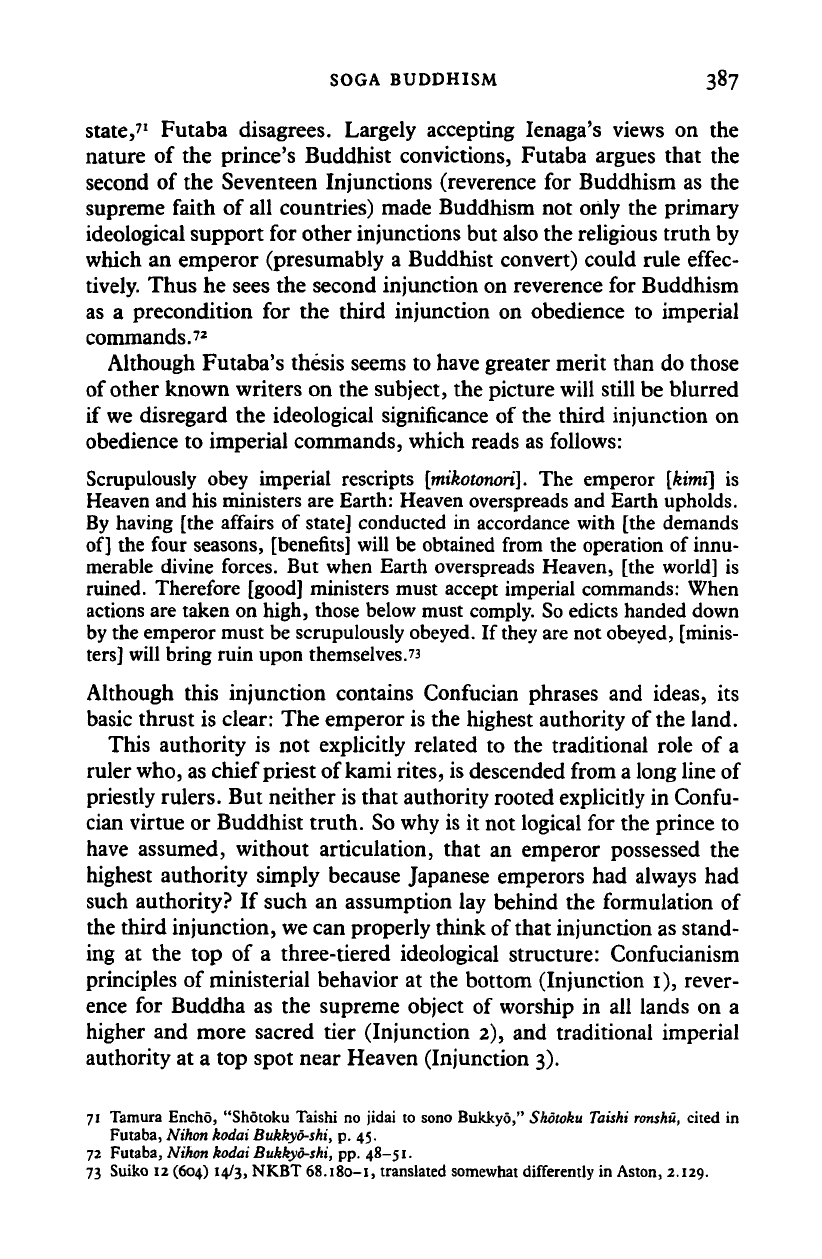
SOGA BUDDHISM 387
state,
71
Futaba disagrees. Largely accepting Ienaga's views on the
nature of the prince's Buddhist convictions, Futaba argues that the
second of the Seventeen Injunctions (reverence for Buddhism as the
supreme faith of all countries) made Buddhism not only the primary
ideological support for other injunctions but also the religious truth by
which an emperor (presumably a Buddhist convert) could rule effec-
tively. Thus he sees the second injunction on reverence for Buddhism
as a precondition for the third injunction on obedience to imperial
commands.
72
Although Futaba's thesis seems to have greater merit than do those
of other known writers on the subject, the picture will still be blurred
if we disregard the ideological significance of the third injunction on
obedience to imperial commands, which reads as follows:
Scrupulously obey imperial rescripts
[mikotonori].
The emperor [kimi] is
Heaven and his ministers are Earth: Heaven overspreads and Earth upholds.
By having [the affairs of state] conducted in accordance with [the demands
of] the four seasons, [benefits] will be obtained from the operation of innu-
merable divine forces. But when Earth overspreads Heaven, [the world] is
ruined. Therefore [good] ministers must accept imperial commands: When
actions are taken on high, those below must comply. So edicts handed down
by the emperor must be scrupulously obeyed. If they are not obeyed, [minis-
ters] will bring ruin upon themselves."
Although this injunction contains Confucian phrases and ideas, its
basic thrust is clear: The emperor is the highest authority of the land.
This authority is not explicitly related to the traditional role of a
ruler who, as chief priest of kami rites, is descended from a long line of
priestly rulers. But neither is that authority rooted explicitly in Confu-
cian virtue or Buddhist truth. So why is it not logical for the prince to
have assumed, without articulation, that an emperor possessed the
highest authority simply because Japanese emperors had always had
such authority? If such an assumption lay behind the formulation of
the third injunction, we can properly think of that injunction as stand-
ing at the top of a three-tiered ideological structure: Confucianism
principles of ministerial behavior at the bottom (Injunction 1), rever-
ence for Buddha as the supreme object of worship in all lands on a
higher and more sacred tier (Injunction 2), and traditional imperial
authority at a top spot near Heaven (Injunction 3).
71 Tamura Encho, "Shotoku Taishi no jidai to sono Bukkyo," Shotoku Taishi
ronshu,
cited in
Futaba, Nihon kodai Bukkyo-shi, p. 45.
72 Futaba, Nihon kodai Bukkyo-shi, pp.
48-51.
73 Suiko 12 (604) 14/3, NKBT 68.180-1, translated somewhat differently in Aston, 2.129.
Cambridge Histories Online © Cambridge University Press, 2008
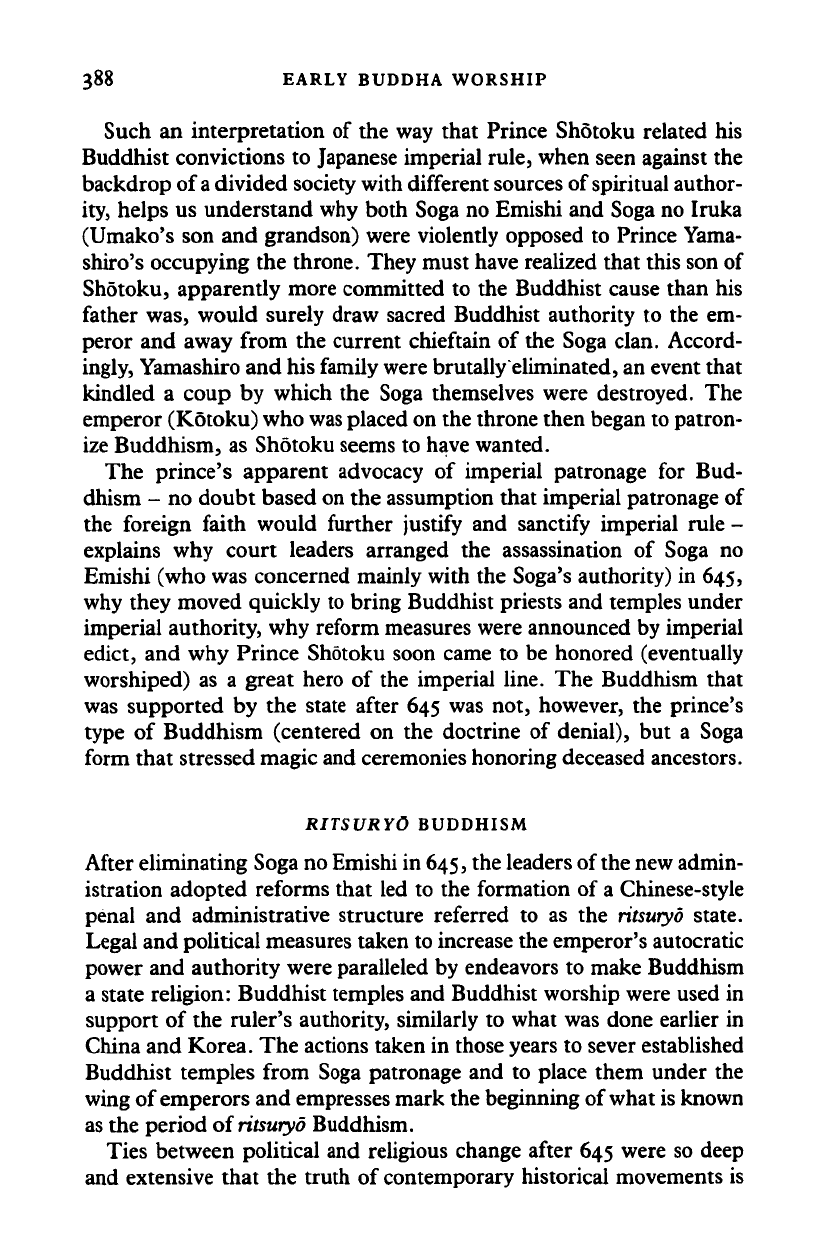
388 EARLY BUDDHA WORSHIP
Such an interpretation of the way that Prince Shotoku related his
Buddhist convictions to Japanese imperial rule, when seen against the
backdrop of
a
divided society with different sources of spiritual author-
ity, helps us understand why both Soga no Emishi and Soga no Iruka
(Umako's son and grandson) were violently opposed to Prince Yama-
shiro's occupying the throne. They must have realized that this son of
Shotoku, apparently more committed to the Buddhist cause than his
father was, would surely draw sacred Buddhist authority to the em-
peror and away from the current chieftain of the Soga clan. Accord-
ingly, Yamashiro and his family were brutally eliminated, an event that
kindled a coup by which the Soga themselves were destroyed. The
emperor (Kotoku) who
was
placed on the throne then began to patron-
ize Buddhism, as Shotoku seems to have wanted.
The prince's apparent advocacy of imperial patronage for Bud-
dhism - no doubt based on the assumption that imperial patronage of
the foreign faith would further justify and sanctify imperial rule -
explains why court leaders arranged the assassination of Soga no
Emishi (who was concerned mainly with the Soga's authority) in 645,
why they moved quickly to bring Buddhist priests and temples under
imperial authority, why reform measures were announced by imperial
edict, and why Prince Shotoku soon came to be honored (eventually
worshiped) as a great hero of the imperial line. The Buddhism that
was supported by the state after 645 was not, however, the prince's
type of Buddhism (centered on the doctrine of denial), but a Soga
form that stressed magic and ceremonies honoring deceased ancestors.
RITSURYO BUDDHISM
After eliminating Soga no Emishi in
645,
the leaders of the new admin-
istration adopted reforms that led to the formation of a Chinese-style
penal and administrative structure referred to as the
ritsuryo
state.
Legal and political measures taken to increase the emperor's autocratic
power and authority were paralleled by endeavors to make Buddhism
a state religion: Buddhist temples and Buddhist worship were used in
support of the ruler's authority, similarly to what was done earlier in
China and Korea. The actions taken in those years to sever established
Buddhist temples from Soga patronage and to place them under the
wing of emperors and empresses mark the beginning of what is known
as the period of
ritsuryo
Buddhism.
Ties between political and religious change after 645 were so deep
and extensive that the truth of contemporary historical movements is
Cambridge Histories Online © Cambridge University Press, 2008
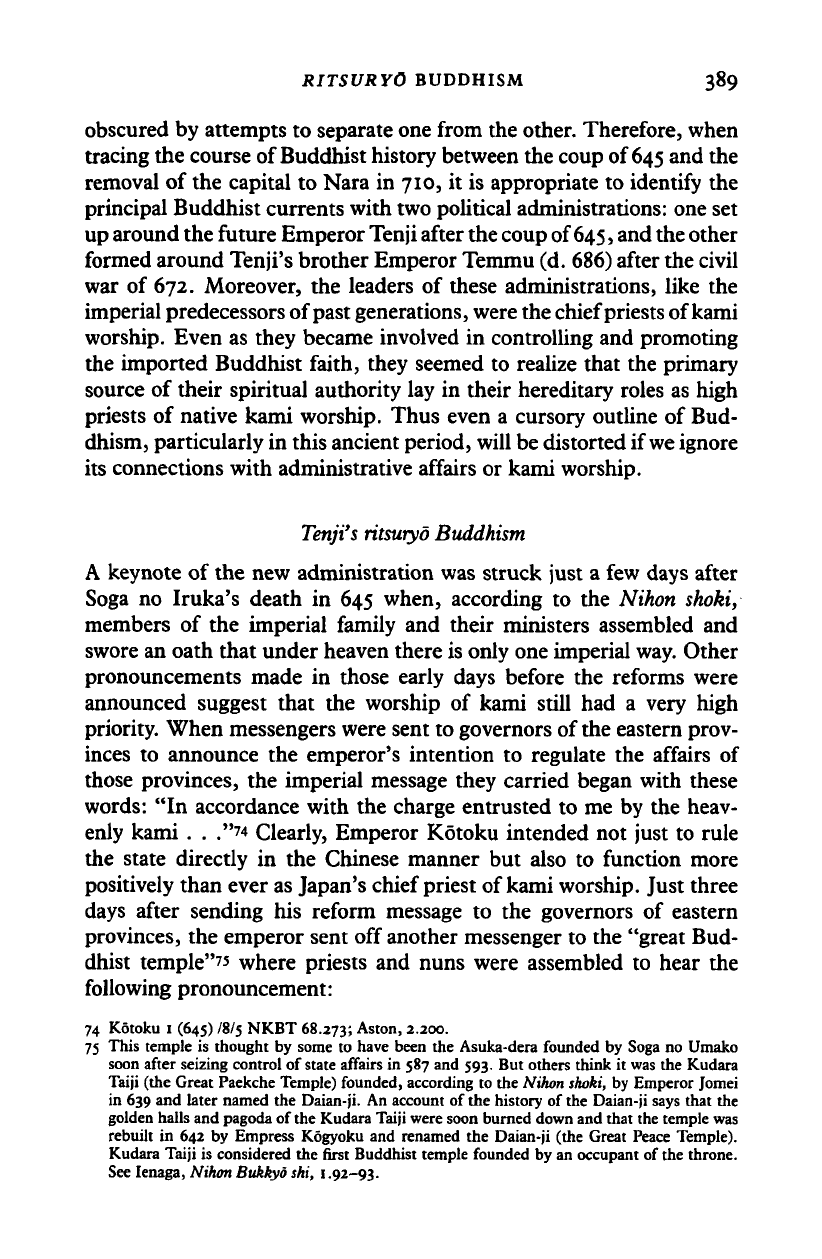
RITSURYO BUDDHISM 389
obscured by attempts to separate one from the other. Therefore, when
tracing the course of Buddhist history between the coup of 645 and the
removal of the capital to Nara in 710, it is appropriate to identify the
principal Buddhist currents with two political administrations: one set
up around the future Emperor Tenji after the coup of
645,
and the other
formed around Tenji's brother Emperor Temmu (d. 686) after the civil
war of 672. Moreover, the leaders of these administrations, like the
imperial predecessors of past generations, were the chief priests of kami
worship. Even as they became involved in controlling and promoting
the imported Buddhist faith, they seemed to realize that the primary
source of their spiritual authority lay in their hereditary roles as high
priests of native kami worship. Thus even a cursory outline of Bud-
dhism, particularly in this ancient period, will be distorted if
we
ignore
its connections with administrative affairs or kami worship.
Tenji's
ritsuryo
Buddhism
A keynote of the new administration was struck just a few days after
Soga no Iruka's death in 645 when, according to the Nihon shoki,
members of the imperial family and their ministers assembled and
swore an oath that under heaven there is only one imperial
way.
Other
pronouncements made in those early days before the reforms were
announced suggest that the worship of kami still had a very high
priority. When messengers were sent to governors of
the
eastern prov-
inces to announce the emperor's intention to regulate the affairs of
those provinces, the imperial message they carried began with these
words: "In accordance with the charge entrusted to me by the heav-
enly kami . . ."74 Clearly, Emperor Kotoku intended not just to rule
the state directly in the Chinese manner but also to function more
positively than ever as Japan's chief priest of kami worship. Just three
days after sending his reform message to the governors of eastern
provinces, the emperor sent off another messenger to the "great Bud-
dhist temple"
75
where priests and nuns were assembled to hear the
following pronouncement:
74 Kotoku 1 (645) /8/5 NKBT 68.273; Aston, 2.200.
75 This temple is thought by some to have been the Asuka-dera founded by Soga no Umako
soon after seizing control of state affairs in 587 and 593. But others think it was the Kudara
Taiji (the Great Paekche Temple) founded, according to the Nihon shoki, by Emperor Jomei
in 639 and later named the Daian-ji. An account of the history of the Daian-ji says that the
golden halls and pagoda of the Kudara Taiji were soon burned down and that the temple was
rebuilt in 642 by Empress Kogyoku and renamed the Daian-ji (the Great Peace Temple).
Kudara Taiji is considered the first Buddhist temple founded by an occupant of the throne.
See lenaga, Nihon Bukkyo shi, 1.92-93.
Cambridge Histories Online © Cambridge University Press, 2008
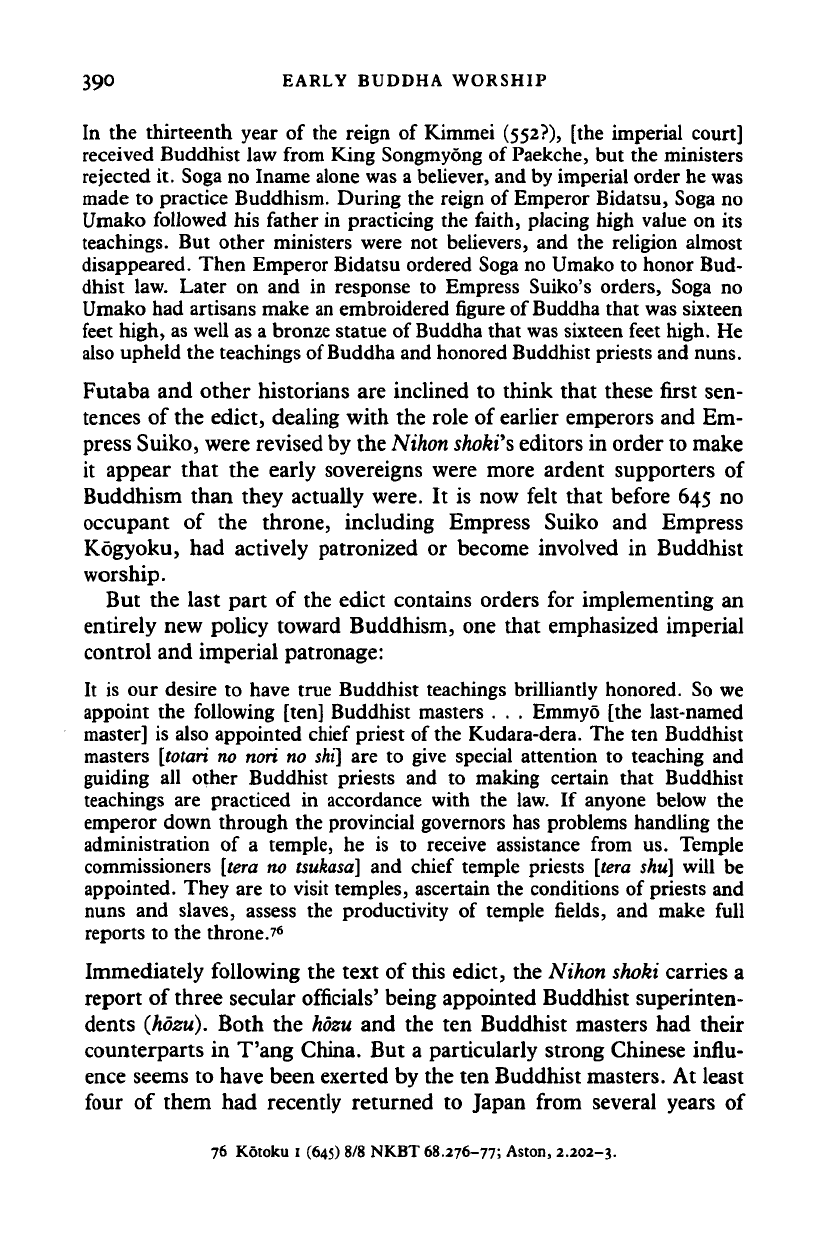
390 EARLY BUDDHA WORSHIP
In
the
thirteenth year
of the
reign
of
Kimmei (552?),
[the
imperial court]
received Buddhist
law
from King Songmyong
of
Paekche,
but the
ministers
rejected it. Soga
no
Iname alone was
a
believer, and by imperial order he was
made
to
practice Buddhism. During
the
reign
of
Emperor Bidatsu, Soga
no
Umako followed
his
father
in
practicing
the
faith, placing high value
on its
teachings.
But
other ministers were
not
believers,
and the
religion almost
disappeared. Then Emperor Bidatsu ordered Soga no Umako
to
honor Bud-
dhist
law.
Later
on and in
response
to
Empress Suiko's orders, Soga
no
Umako
had
artisans make an embroidered figure of Buddha that was sixteen
feet high,
as
well
as a
bronze statue
of
Buddha that was sixteen feet high.
He
also upheld the teachings of Buddha and honored Buddhist priests and nuns.
Futaba and other historians are inclined to think that these first sen-
tences of the edict, dealing with the role of earlier emperors and Em-
press Suiko, were revised by the Nihon
shoki's
editors in order to make
it appear that the early sovereigns were more ardent supporters of
Buddhism than they actually were. It is now felt that before 645 no
occupant of the throne, including Empress Suiko and Empress
Kogyoku, had actively patronized or become involved in Buddhist
worship.
But the last part of the edict contains orders for implementing an
entirely new policy toward Buddhism, one that emphasized imperial
control and imperial patronage:
It
is our
desire
to
have true Buddhist teachings brilliantly honored.
So we
appoint
the
following [ten] Buddhist masters
. . .
Emmyo
[the
last-named
master]
is
also appointed chief priest
of
the Kudara-dera.
The ten
Buddhist
masters
[totari
no
nori
no
shi]
are to
give special attention
to
teaching
and
guiding
all
other Buddhist priests
and to
making certain that Buddhist
teachings
are
practiced
in
accordance with
the law. If
anyone below
the
emperor down through
the
provincial governors
has
problems handling
the
administration
of a
temple,
he is to
receive assistance from
us.
Temple
commissioners
[tera
no
tsukasa]
and
chief temple priests
[tera
shu] will
be
appointed. They
are to
visit temples, ascertain
the
conditions
of
priests
and
nuns
and
slaves, assess
the
productivity
of
temple fields,
and
make full
reports
to the
throne.'
6
Immediately following the text of this edict, the Nihon
shoki
carries a
report of three secular officials' being appointed Buddhist superinten-
dents
Qiozu).
Both the hozu and the ten Buddhist masters had their
counterparts in T'ang China. But a particularly strong Chinese influ-
ence seems to have been exerted by the ten Buddhist masters. At least
four of them had recently returned to Japan from several years of
76 Kotoku
1
(645) 8/8 NKBT 68.276-77; Aston, 2.202-3.
Cambridge Histories Online © Cambridge University Press, 2008
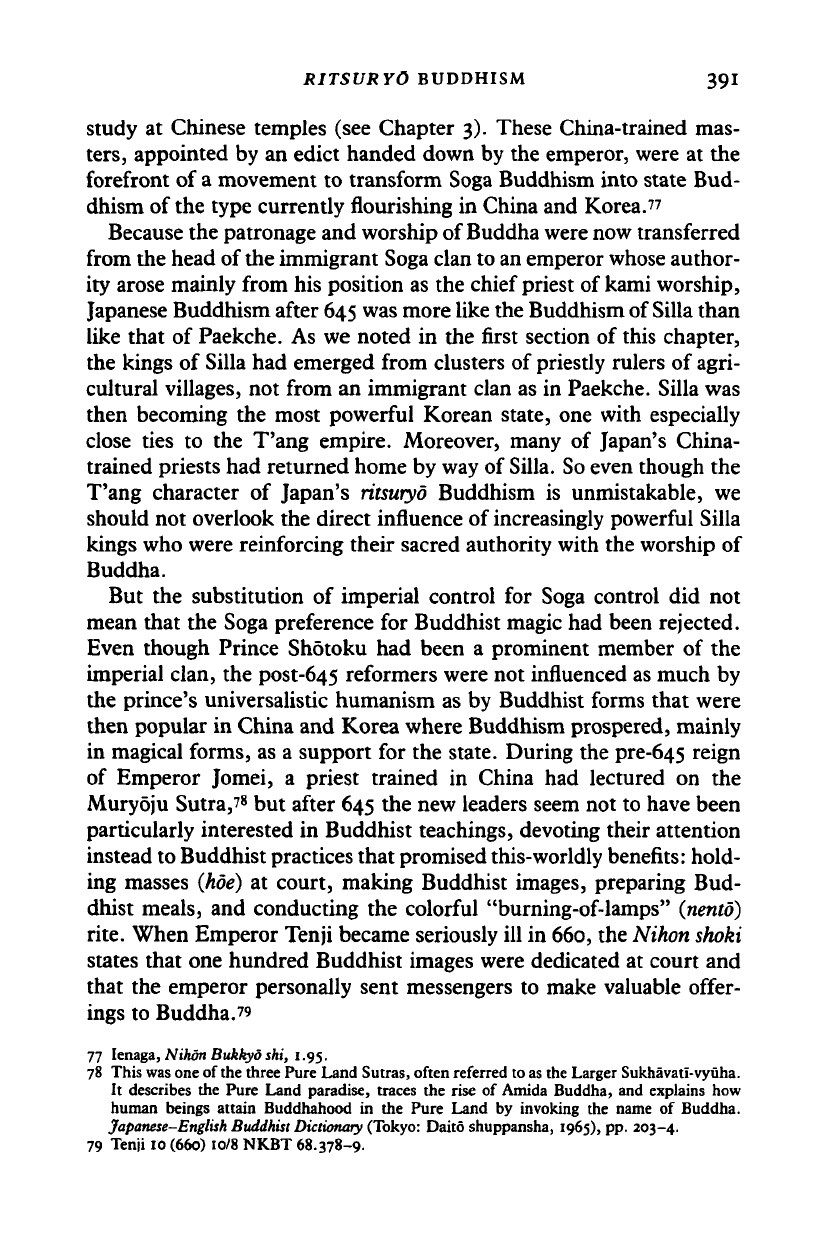
RITSURYO BUDDHISM 391
study at Chinese temples (see Chapter 3). These China-trained mas-
ters,
appointed by an edict handed down by the emperor, were at the
forefront of
a
movement to transform Soga Buddhism into state Bud-
dhism of the type currently flourishing in China and Korea.
77
Because the patronage and worship of Buddha were now transferred
from the head of the immigrant Soga clan to an emperor whose author-
ity arose mainly from his position as the chief priest of kami worship,
Japanese Buddhism after
645
was more like the Buddhism of Silla than
like that of Paekche. As we noted in the first section of this chapter,
the kings of Silla had emerged from clusters of priestly rulers of agri-
cultural villages, not from an immigrant clan as in Paekche. Silla was
then becoming the most powerful Korean state, one with especially
close ties to the T'ang empire. Moreover, many of Japan's China-
trained priests had returned home by way of
Silla.
So even though the
T'ang character of Japan's
ritsuryo
Buddhism is unmistakable, we
should not overlook the direct influence of increasingly powerful Silla
kings who were reinforcing their sacred authority with the worship of
Buddha.
But the substitution of imperial control for Soga control did not
mean that the Soga preference for Buddhist magic had been rejected.
Even though Prince Shotoku had been a prominent member of the
imperial clan, the post-645 reformers were not influenced as much by
the prince's universalistic humanism as by Buddhist forms that were
then popular in China and Korea where Buddhism prospered, mainly
in magical forms, as a support for the state. During the pre-645 reign
of Emperor Jomei, a priest trained in China had lectured on the
Muryoju Sutra,
78
but after 645 the new leaders seem not to have been
particularly interested in Buddhist teachings, devoting their attention
instead to Buddhist practices that promised this-worldly benefits: hold-
ing masses
(hoe)
at court, making Buddhist images, preparing Bud-
dhist meals, and conducting the colorful "burning-of-lamps"
(nento)
rite.
When Emperor Tenji became seriously ill in 660, the
Nihott shoki
states that one hundred Buddhist images were dedicated at court and
that the emperor personally sent messengers to make valuable offer-
ings to Buddha.
79
77 Ienaga, Nihon Bukkyo shi, 1.95.
78 This was one of the three Pure Land Sutras, often referred to as the Larger Sukhavatl-vyuha.
It describes the Pure Land paradise, traces the rise of Amida Buddha, and explains how
human beings attain Buddhahood in the Pure Land by invoking the name of Buddha.
Japanese-English Buddhist Dictionary (Tokyo: Daito shuppansha, 1965), pp. 203-4.
79 Tenji 10 (660) 10/8 NKBT 68.378-9.
Cambridge Histories Online © Cambridge University Press, 2008
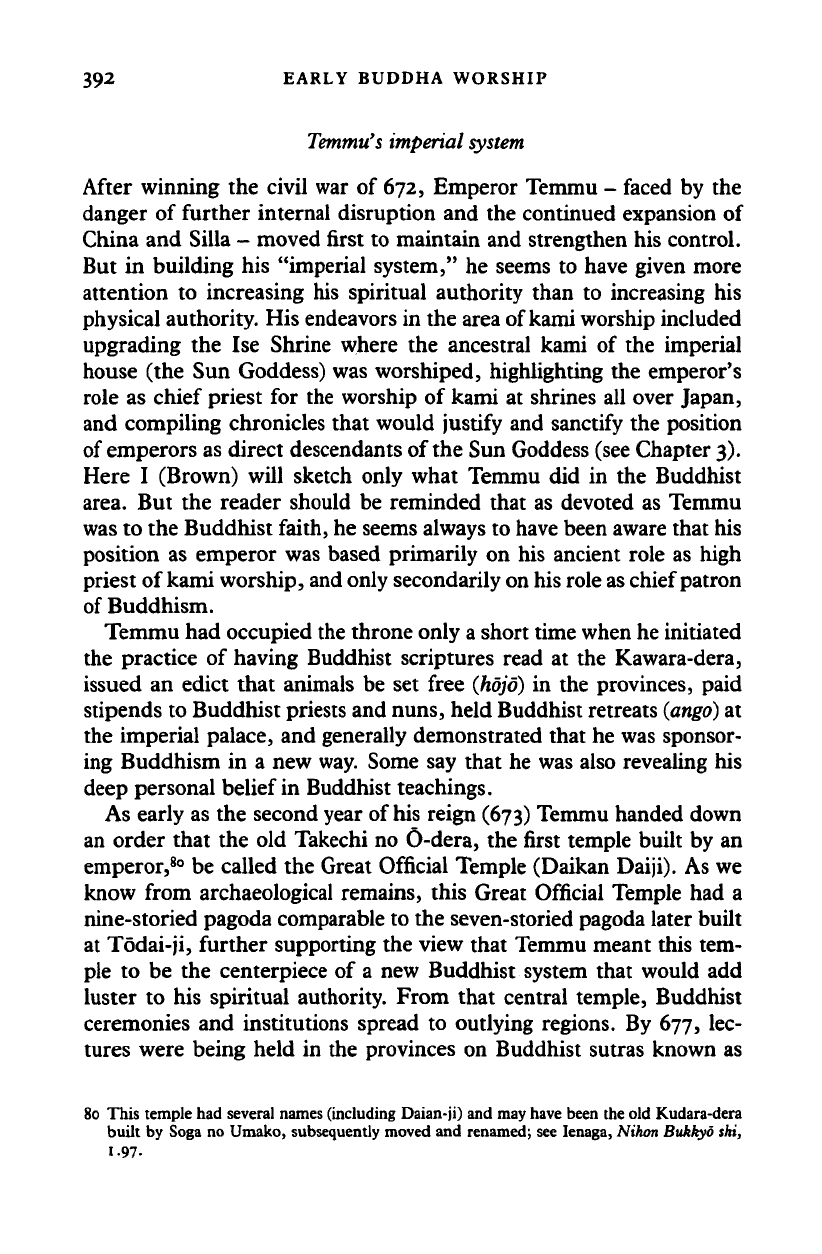
392 EARLY BUDDHA WORSHIP
Temmu's imperial
system
After winning the civil war of 672, Emperor Temmu - faced by the
danger of further internal disruption and the continued expansion of
China and Silla - moved first to maintain and strengthen his control.
But in building his "imperial system," he seems to have given more
attention to increasing his spiritual authority than to increasing his
physical authority. His endeavors in the area of kami worship included
upgrading the Ise Shrine where the ancestral kami of the imperial
house (the Sun Goddess) was worshiped, highlighting the emperor's
role as chief priest for the worship of kami at shrines all over Japan,
and compiling chronicles that would justify and sanctify the position
of emperors as direct descendants of the Sun Goddess (see Chapter 3).
Here I (Brown) will sketch only what Temmu did in the Buddhist
area. But the reader should be reminded that as devoted as Temmu
was to the Buddhist faith, he seems always to have been aware that his
position as emperor was based primarily on his ancient role as high
priest of kami worship, and only secondarily on his role as chief patron
of Buddhism.
Temmu had occupied the throne only a short time when he initiated
the practice of having Buddhist scriptures read at the Kawara-dera,
issued an edict that animals be set free
(hojo)
in the provinces, paid
stipends to Buddhist priests and nuns, held Buddhist retreats
(ango)
at
the imperial palace, and generally demonstrated that he was sponsor-
ing Buddhism in a new way. Some say that he was also revealing his
deep personal belief in Buddhist teachings.
As early as the second year of
his
reign (673) Temmu handed down
an order that the old Takechi no O-dera, the first temple built by an
emperor,
80
be called the Great Official Temple (Daikan Daiji). As we
know from archaeological remains, this Great Official Temple had a
nine-storied pagoda comparable to the seven-storied pagoda later built
at T6dai-ji, further supporting the view that Temmu meant this tem-
ple to be the centerpiece of a new Buddhist system that would add
luster to his spiritual authority. From that central temple, Buddhist
ceremonies and institutions spread to outlying regions. By 677, lec-
tures were being held in the provinces on Buddhist sutras known as
80 This temple had several names (including Daian-ji) and may have been the old Kudara-dera
built by Soga no Umako, subsequently moved and renamed; see Ienaga,
Nihon
Bukkyo shi,
1-97-
Cambridge Histories Online © Cambridge University Press, 2008
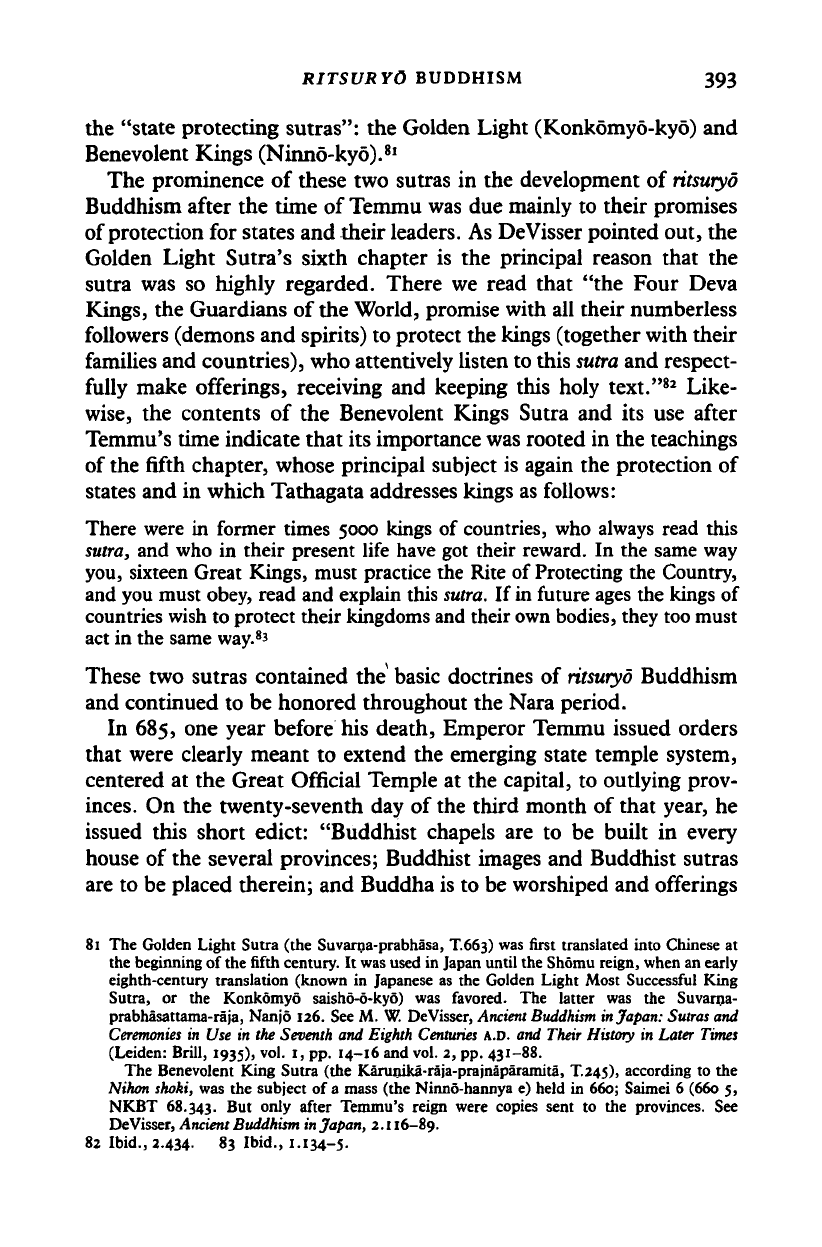
RITSURYO BUDDHISM 393
the "state protecting sutras": the Golden Light (Konkomyo-kyo) and
Benevolent Kings (Ninno-kyo).
81
The prominence of these two sutras in the development of
ritsuryo
Buddhism after the time of Temmu was due mainly to their promises
of protection for states and their
leaders.
As DeVisser pointed out, the
Golden Light Sutra's sixth chapter is the principal reason that the
sutra was so highly regarded. There we read that "the Four Deva
Kings, the Guardians of the World, promise with all their numberless
followers (demons and spirits) to protect the kings (together with their
families and countries), who attentively listen to this
sutra
and respect-
fully make offerings, receiving and keeping this holy text."
82
Like-
wise,
the contents of the Benevolent Kings Sutra and its use after
Temmu's time indicate that its importance was rooted in the teachings
of the fifth chapter, whose principal subject is again the protection of
states and in which Tathagata addresses kings as follows:
There were in former times 5000 kings of countries, who always read this
sutra, and who in their present life have got their reward. In the same way
you, sixteen Great Kings, must practice the Rite of Protecting the Country,
and you must obey, read and explain this sutra. If in future ages the kings of
countries wish to protect their kingdoms and their own bodies, they too must
act in the same way.
8
*
These two sutras contained the basic doctrines of
ritsuryo
Buddhism
and continued to be honored throughout the Nara period.
In 685, one year before his death, Emperor Temmu issued orders
that were clearly meant to extend the emerging state temple system,
centered at the Great Official Temple at the capital, to outlying prov-
inces.
On the twenty-seventh day of the third month of that year, he
issued this short edict: "Buddhist chapels are to be built in every
house of the several provinces; Buddhist images and Buddhist sutras
are to be placed therein; and Buddha is to be worshiped and offerings
81 The Golden Light Sutra (the Suvarna-prabhasa, T.663) was first translated into Chinese at
the beginning of the fifth century. It was used in Japan until the Shomu reign, when an early
eighth-century translation (known in Japanese as the Golden Light Most Successful King
Sutra, or the Konkomyo saisho-6-kyo) was favored. The latter was the Suvarna-
prabhasattama-raja, Nanjo 126. See M. W. DeVisser,
Ancient Buddhism in
Japan: Sutras and
Ceremonies
in Use in the Seventh and Eighth
Centuries
A.D. and Their History in Later Times
(Leiden: Brill, 1935), vol. 1, pp. 14-16 and vol. 2, pp. 431-88.
The Benevolent King Sutra (the Karunika-raja-prajnaparamita, T.245), according to the
Nihon skoki, was the subject of a mass (the Ninno-hannya e) held in 660; Saimei 6 (660 5,
NKBT 68.343. But only after Temmu's reign were copies sent to the provinces. See
DeVisser, Ancient Buddhism
in
Japan, 2.116-89.
82 Ibid., 2.434. 83 Ibid., 1.134-5.
Cambridge Histories Online © Cambridge University Press, 2008
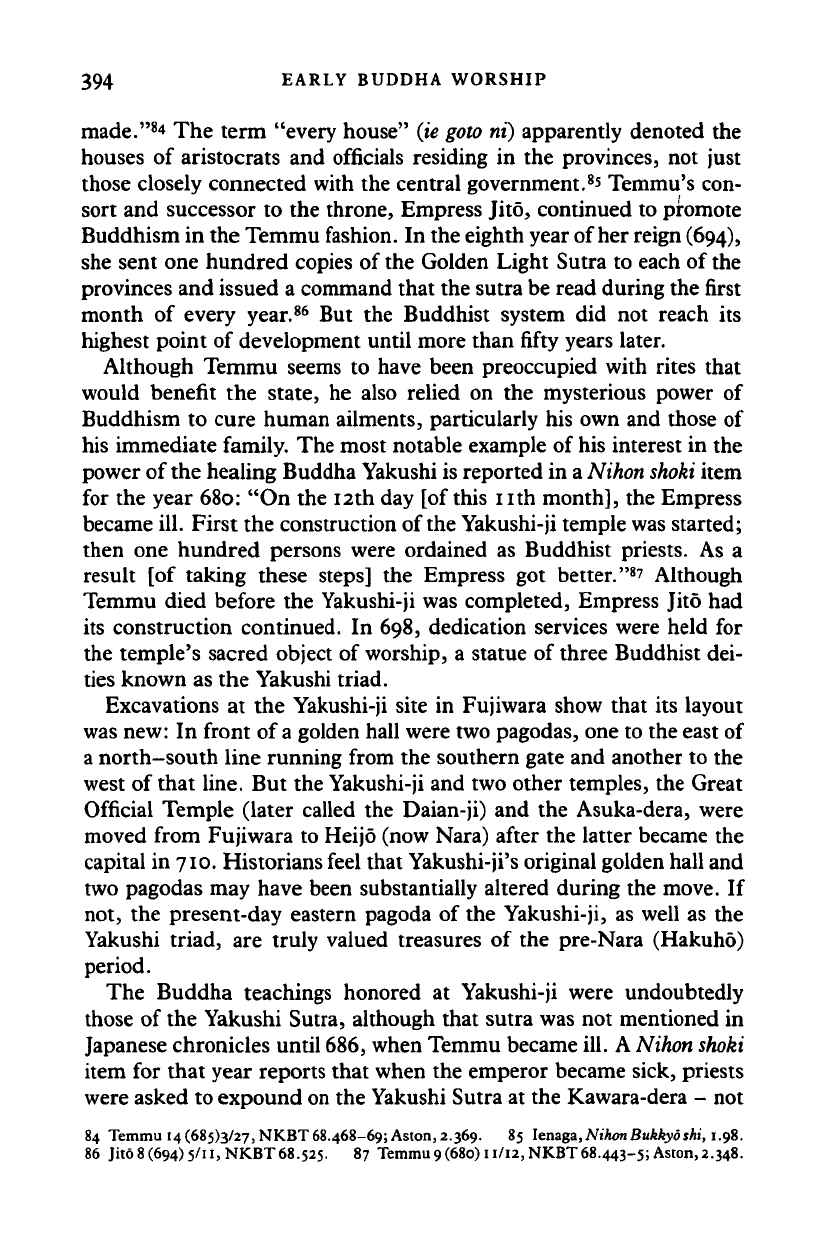
394 EARLY BUDDHA WORSHIP
made."
84
The term "every house"
(ie goto
ni) apparently denoted the
houses of aristocrats and officials residing in the provinces, not just
those closely connected with the central government.
85
Temmu's con-
sort and successor to the throne, Empress Jito, continued to promote
Buddhism in the Temmu fashion. In the eighth year of her reign (694),
she sent one hundred copies of the Golden Light Sutra to each of the
provinces and issued a command that the sutra be read during the first
month of every year.
86
But the Buddhist system did not reach its
highest point of development until more than fifty years later.
Although Temmu seems to have been preoccupied with rites that
would benefit the state, he also relied on the mysterious power of
Buddhism to cure human ailments, particularly his own and those of
his immediate family. The most notable example of his interest in the
power of the healing Buddha Yakushi is reported in
a Nihon shoki
item
for the year 680: "On the 12th day [of this nth month], the Empress
became ill. First the construction of the Yakushi-ji temple was started;
then one hundred persons were ordained as Buddhist priests. As a
result [of taking these steps] the Empress got better."
87
Although
Temmu died before the Yakushi-ji was completed, Empress Jito had
its construction continued. In 698, dedication services were held for
the temple's sacred object of worship, a statue of three Buddhist dei-
ties known as the Yakushi triad.
Excavations at the Yakushi-ji site in Fujiwara show that its layout
was new: In front of a golden hall were two pagodas, one to the east of
a north-south line running from the southern gate and another to the
west of that line. But the Yakushi-ji and two other temples, the Great
Official Temple (later called the Daian-ji) and the Asuka-dera, were
moved from Fujiwara to Heijd (now Nara) after the latter became the
capital in 710. Historians feel that Yakushi-ji's original golden hall and
two pagodas may have been substantially altered during the move. If
not, the present-day eastern pagoda of the Yakushi-ji, as well as the
Yakushi triad, are truly valued treasures of the pre-Nara (Hakuho)
period.
The Buddha teachings honored at Yakushi-ji were undoubtedly
those of the Yakushi Sutra, although that sutra was not mentioned in
Japanese chronicles until 686, when Temmu became
ill.
A
Nihon
shoki
item for that year reports that when the emperor became sick, priests
were asked to expound on the Yakushi Sutra at the Kawara-dera - not
84 Temmu
14
(685)3/27, NKBT
68.468-69;
Aston,
2.369. 85 lemga,
NihonBukkyoshi,
1.98.
86 Jit68(694)5/n,NKBT68.525. 87 Temmu9(68o)u/i2,NKBT68.443-5;Aston,2.348.
Cambridge Histories Online © Cambridge University Press, 2008
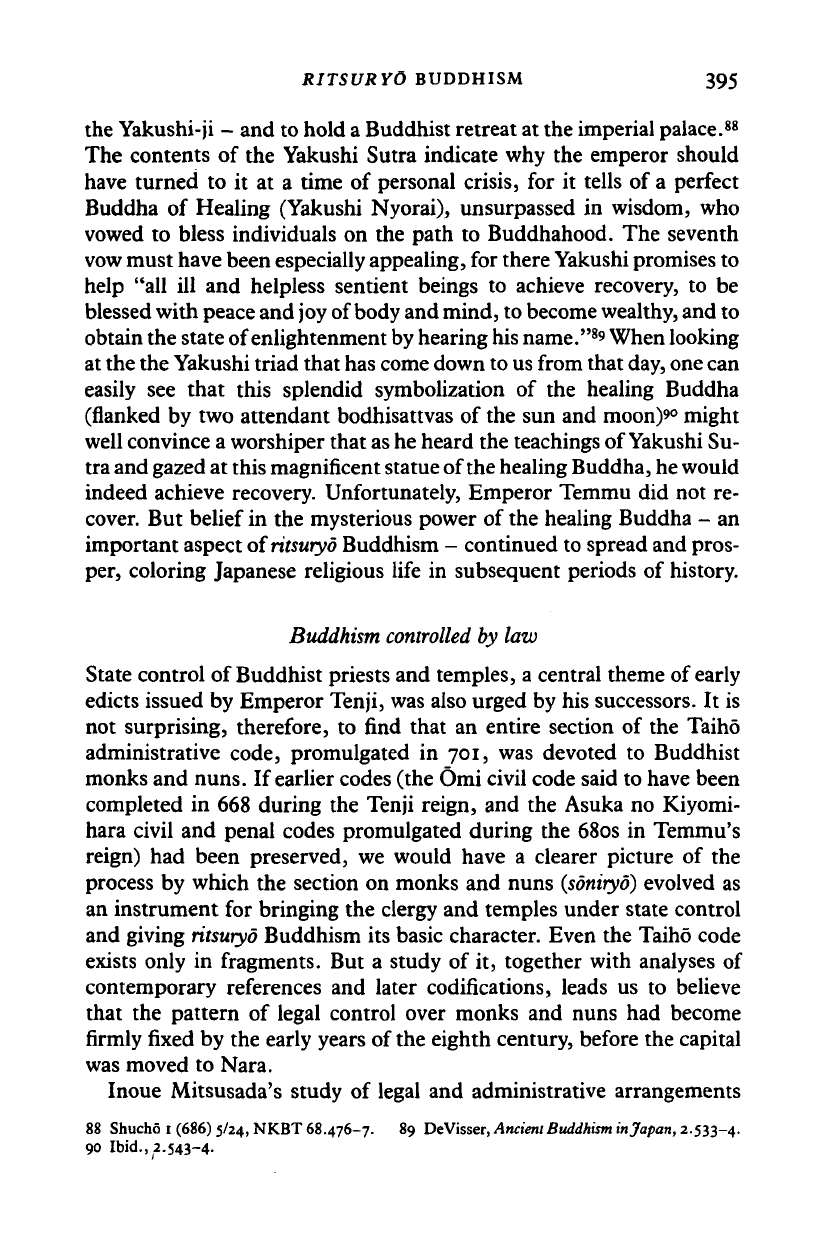
RITSURYO BUDDHISM 395
the Yakushi-ji - and to hold a Buddhist retreat at the imperial palace.
88
The contents of the Yakushi Sutra indicate why the emperor should
have turned to it at a time of personal crisis, for it tells of a perfect
Buddha of Healing (Yakushi Nyorai), unsurpassed in wisdom, who
vowed to bless individuals on the path to Buddhahood. The seventh
vow
must have been especially appealing, for there Yakushi promises to
help "all ill and helpless sentient beings to achieve recovery, to be
blessed with peace and joy of body and mind, to become wealthy, and to
obtain the state of enlightenment
by
hearing
his
name."
89
When looking
at the the Yakushi triad that has come down to us from that
day,
one can
easily see that this splendid symbolization of the healing Buddha
(flanked by two attendant bodhisattvas of the sun and moon)
90
might
well convince a worshiper that as he heard the teachings of Yakushi Su-
tra and gazed at this magnificent statue of the healing Buddha, he would
indeed achieve recovery. Unfortunately, Emperor Temmu did not re-
cover. But belief in the mysterious power of the healing Buddha - an
important aspect of
ritsuryo
Buddhism - continued to spread and pros-
per, coloring Japanese religious life in subsequent periods of history.
Buddhism
controlled
by law
State control of Buddhist priests and temples, a central theme of early
edicts issued by Emperor Tenji, was also urged by his successors. It is
not surprising, therefore, to find that an entire section of the Taiho
administrative code, promulgated in 701, was devoted to Buddhist
monks and nuns. If earlier codes (the Omi civil code said to have been
completed in 668 during the Tenji reign, and the Asuka no Kiyomi-
hara civil and penal codes promulgated during the 680s in Temmu's
reign) had been preserved, we would have a clearer picture of the
process by which the section on monks and nuns
(soniryo)
evolved as
an instrument for bringing the clergy and temples under state control
and giving
ritsuryo
Buddhism its basic character. Even the Taiho code
exists only in fragments. But a study of it, together with analyses of
contemporary references and later codifications, leads us to believe
that the pattern of legal control over monks and nuns had become
firmly fixed by the early years of the eighth century, before the capital
was moved to Nara.
Inoue Mitsusada's study of legal and administrative arrangements
88 Shucho
1
(686) 5/24, NKBT 68.476-7. 89 DeVisser,
Ancient Buddhism
in Japan, 2.533-4.
90 Ibid., 2.543-4.
Cambridge Histories Online © Cambridge University Press, 2008
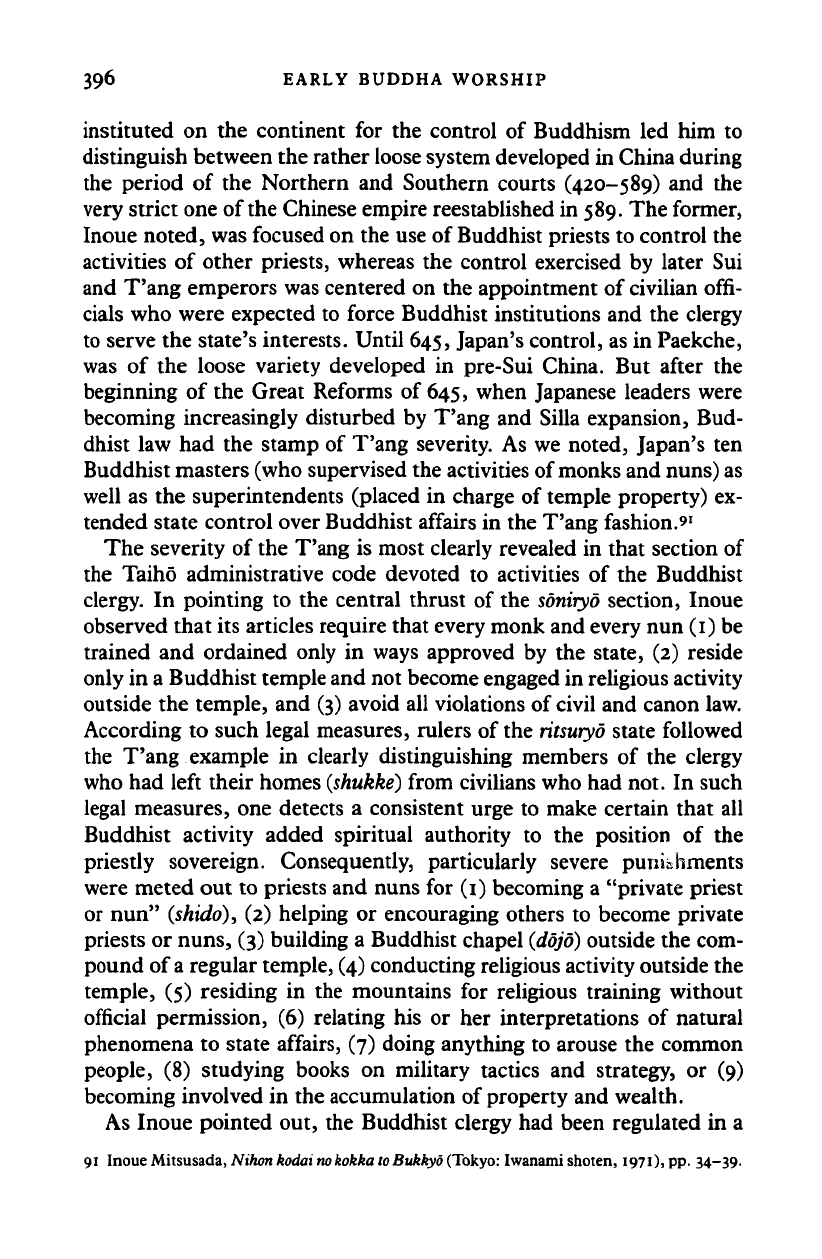
396 EARLY BUDDHA WORSHIP
instituted on the continent for the control of Buddhism led him to
distinguish between the rather loose system developed in China during
the period of the Northern and Southern courts (420-589) and the
very strict one of the Chinese empire reestablished in
589.
The former,
Inoue noted, was focused on the use of Buddhist priests to control the
activities of other priests, whereas the control exercised by later Sui
and T'ang emperors was centered on the appointment of civilian offi-
cials who were expected to force Buddhist institutions and the clergy
to serve the state's interests. Until
645,
Japan's control, as in Paekche,
was of the loose variety developed in pre-Sui China. But after the
beginning of the Great Reforms of
645,
when Japanese leaders were
becoming increasingly disturbed by T'ang and Silla expansion, Bud-
dhist law had the stamp of T'ang severity. As we noted, Japan's ten
Buddhist masters (who supervised the activities of monks and nuns) as
well as the superintendents (placed in charge of temple property) ex-
tended state control over Buddhist affairs in the T'ang fashion.'
1
The severity of the T'ang is most clearly revealed in that section of
the Taiho administrative code devoted to activities of the Buddhist
clergy. In pointing to the central thrust of the
soniryo
section, Inoue
observed that its articles require that every monk and every nun (1) be
trained and ordained only in ways approved by the state, (2) reside
only in a Buddhist temple and not become engaged in religious activity
outside the temple, and (3) avoid all violations of civil and canon law.
According to such legal measures, rulers of the
ritsuryo
state followed
the T'ang example in clearly distinguishing members of the clergy
who had left their homes
(shukke)
from civilians who had not. In such
legal measures, one detects a consistent urge to make certain that all
Buddhist activity added spiritual authority to the position of the
priestly sovereign. Consequently, particularly severe punishments
were meted out to priests and nuns for (1) becoming a "private priest
or nun"
(shido),
(2) helping or encouraging others to become private
priests or nuns, (3) building a Buddhist chapel
(dojo)
outside the com-
pound of
a
regular temple, (4) conducting religious activity outside the
temple, (5) residing in the mountains for religious training without
official permission, (6) relating his or her interpretations of natural
phenomena to state affairs, (7) doing anything to arouse the common
people, (8) studying books on military tactics and strategy, or (9)
becoming involved in the accumulation of property and wealth.
As Inoue pointed out, the Buddhist clergy had been regulated in a
91 Inoue tAilsusada, Nthonkodai nokokka toBukkyo
(Tokyo:
Iwanami shoten, I97i),pp. 34-39.
Cambridge Histories Online © Cambridge University Press, 2008
